White Cliffs of Dover
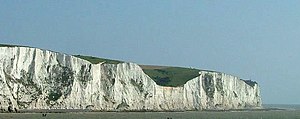

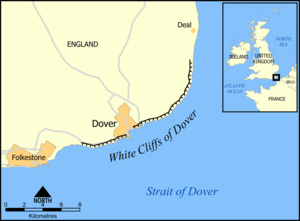
The White Cliffs of Dover are chalk cliffs in Kent, forming part of the coastline of Great Britain facing the Strait of Dover. The cliffs are part of the North Downs formation. The cliff face, which reaches up to 350 feet,[1] owes its striking façade to its composition of chalk accentuated by streaks of black flint. The cliffs spread east and west along the Kentish coast from the ancient and modern port of Dover, which town sits crammed into a gap in the cliffs.
The cliffs have great symbolic value for Britain because they face towards Europe across the narrowest part of the English Channel, where invasions have historically threatened and against which the cliffs form a symbolic guard. Because crossing at Dover was the primary route to the continent before air travel, the white line of cliffs also formed the first or last sight of Britain for travellers.
Location
The cliffs are located along the coastline between approximately: Latitude 51°06'N, Longitude 1°14'E and Latitude 51°12'N, Longitude 1°24'E. Shakespeare Cliff marks the point where Great Britain most closely approaches Europe. On a clear day, the cliffs are easily visible from the French coast.
Geology
The cliffs are composed mainly of soft, white chalk with a very fine-grained texture, composed primarily of coccoliths, plates of calcium carbonate formed by coccolithophores, single-celled planktonic algae whose skeletal remains sank to the bottom of the ocean and, together with the remains of bottom-living creatures, formed sediments. Flint and quartz are also found in the chalk.[2] White cliffs like those of Dover are also found on the Danish islands of Møn and Langeland or the coasts of the island of Rügen in Germany.
The cliff face continues to weather at an average rate of ½ inch a year, although occasionally large pieces will fall. Such an event occurred in 2001, when a large chunk of the edge, as large as a football pitch, fell into the channel.[3] A further large section collapsed into the English Channel on 15 March 2012.[4] Visitors are, therefore, urged to remain well away from the cliff edge.
Culture
The White Cliffs, Britain's wall facing the unquiet continent, are a poignant symbol of Britain. Throughout the centuries, the cliffs have been a symbol of home to Britons abroad; the last place seen when sailing forth toward France, in peace and war, and the first to greet our return. The White Cliffs blaze brightly in the sun, clearly visible from the French coast when the mist lifts from the sea.
Shakespeare Cliff is the most famous part of the cliffs. Its name is far from ancient, but was given in honour of William Shakespeare's King Lear: in the play, the blinded Earl of Gloucester bids Poor Tom (who is his own son Edgar in disguise) to take him to the cliff at Dover in order that he might throw himself off:
| “ | There is a cliff, whose high and bending head looks fearfully on the confined deep | ” |
"Tom" leads him to a safe place instead:
Come on, sir; here's the place: stand still. How fearful
And dizzy 'tis to cast one's eyes so low!
The crows and choughs that wing the midway air
Show scarce so gross as beetles: half way down
Hangs one that gathers samphire, dreadful trade!
Methinks he seems no bigger than his head:
The fishermen that walk upon the beach
Appear like mice; and yond tall anchoring bark
Diminish'd to her cock; her cock a buoy
Almost too small for sight: the murmering surge,
That on the unnumber'd idle pebbles chafes,
Cannot be heard so high. I'll look no more;
Lest my brain turn, and the deficient sight
Topple down headlong."[5]
In 1942, during the War, Vera Lynn ("the Forces' Sweetheart") recorded "Bluebirds over the White Cliffs of Dover" as a tribute to pilots battling the Luftwaffe in Europe and over Kent, and it became her best-known song:
There'll be blue - birds over the white cliffs of Dover
Tomorrow - just you wait and see.
There'll be love and laughter and peace ever after
Tomorrow when the world is free.
The song was written in 1941 by two American lyricists, Walter Kent and Nat Burton, who might not have appreciated that bluebirds are unknown in the British Isles, but it was one of the most popular songs during the war years.
In a 2005 poll of Radio Times readers, the cliffs were named as the third greatest natural wonder in Britain.
Wildlife
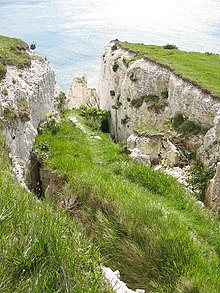 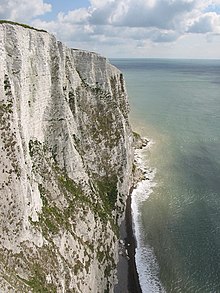 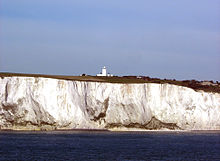 |
Several species of cliff nesting birds nest on the cliff face, including fulmars and colonies of black-legged kittiwake.
However, whatever the song might have claimed, there are no bluebirds nor ever have been; they are an American species not found in Britain.
See also
- Beachy Head, Sussex
- Seven Sisters, Sussex
Outside links
| ("Wikimedia Commons" has material about Cliffs of Dover White Cliffs of Dover) |
References
- ↑ "Coastal walk – White Cliffs of Dover, South-East Kent". The National Trust. http://www.nationaltrust.org.uk/main/w-coastal_walk-white_cliffs_dover.pdf.
- ↑ Harris, C.S.. "Chalk facts". Geology Shop. http://www.geologyshop.co.uk/chalk.htm.
- ↑ Beard, Matthew (February 1, 2001). "White cliffs of Dover go crashing into the Channel". The Independent. http://www.independent.co.uk/news/uk/this-britain/white-cliffs-of-dover-go-crashing-into-the-channel-705291.html. Retrieved 2010-04-18.
- ↑ "BBC News - White Cliffs of Dover suffer large collapse". BBC News. http://www.bbc.co.uk/news/uk-17389616.
- ↑ King Lear, Act IV scene VI
